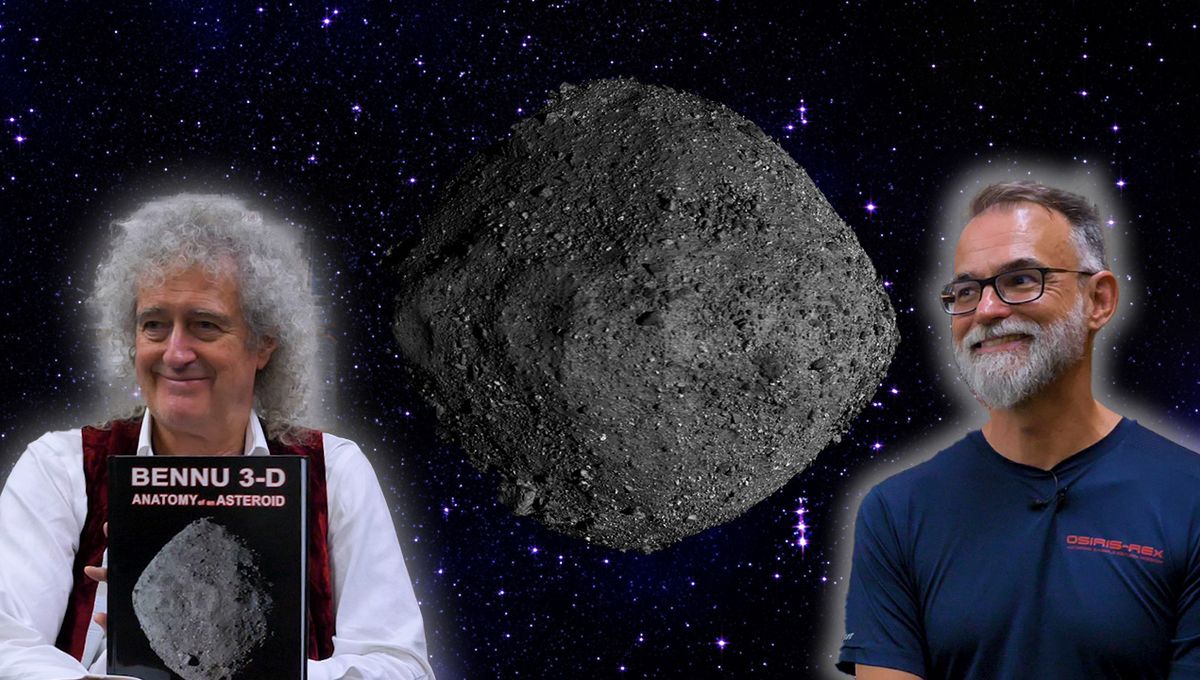
In October 2020, NASA’s OSIRIS-REx flew down to the surface of asteroid Bennu to collect a sample of material. The spacecraft is on its way back to Earth now and it will drop the precious cargo on September 24. Bennu is the most dangerous known asteroid with a very small chance of hitting Earth in the 2100s and 2200s. The sample will bring rocks full of insights into the beginning of the solar system – and the collection was massively helped by Queen’s Brian May.
May is not only a legendary rockstar and an outspoken environmentalist, he is also an astrophysicist whose PhD thesis focused on Zodiacal Light, the ghostly glow that can appear in the sky like a false dawn or post-sunset. He’s also been involved in Asteroid Day, a UN-sanctioned global awareness campaign about the risks of an asteroid impact. In the context of the initiative, he met Professor Dante Lauretta, the Principal Investigator of OSIRIS-REx. This encounter has shaped the mission and resulted in the two of them publishing a book on this critical collaboration.
IFLScience was invited to the launch of their work, called Bennu 3-D: Anatomy of an Asteroid. They showcased incredible three-dimensional views of Asteroid Bennu that showed how the asteroid is not a simple rubble pile, as it is affectionally described, but a spacecraft-killer rubble pile. Without those views, the risk was not obvious.
The interview can be watched below and on our YouTube channel. It gives insights into their work together, the scientific value of asteroid Bennu, and the mission. We also explore why the involvement of May in the OSIRIS-REx mission was so important to its success – and it really was.
The 3D views came from May and his collaborator Claudia Manzoni. They produced stereoscopic images, pairs of images that produce the illusion of depth by being taken at slightly different angles and being seen with glasses. At first, they just picked images made publicly available and, once ready, shared them with Lauretta. It was at that point that the OSIRIS-REx team realized that these views could become mission-critical.
“It really changed my whole perspective of the data. All of a sudden a new dimension opened up,” Professor Lauretta told IFLScience.
Lauretta invited May and Manzoni to become part of the mission by producing more 3D views of the asteroid. The goal was to help the team work out where was the best place to fly down and collect the sample. Something easier said than done. There was a single camera, so the pair had to match two views of the same region at slightly different angles, but also correct for the shadows as Bennu spins every 4.3 hours on its axis, so the sun-casted shadows quickly move.
“We assembled stereo images, 3D images, from all kinds of missions, and [being involved with the mission] was a kind of dream to me,” Sir May told IFLScience. “Suddenly I had this real scientist who was sending me stuff to do and it becomes kind of like a job because it was a lot of hours to put in, but it’s joy, it’s just such a joy to work on these images.”
Bennu is like a time capsule, holding information about what it was like when the Earth was born. Studying it is a unique window into the past. The most intriguing material that the team could observe from orbit was in relatively small craters, some surrounded by boulders and steep walls. May and Manzoni’s 3D images were key to eventually selecting the landing site.
The spacecraft’s goal was to collect at least 60 grams (2.1 ounces) of material. The team estimated that between 150 and 350 grams (5.3 to 12.3 ounces) were collected. Truly a treasure trove. Once the capsule is safely back on Earth – the team has been practicing the retrieval – the spacecraft will continue its journey into space towards another notoriously dangerous asteroid: Apophis. Then, it will get its name changed to OSIRIS-APEX.
Apophis is a concerning object with possible collision dates with our planet in 2029, 2036, and 2068. But observations in 2021 have shown that we shouldn’t worry for at least a century. The most dangerous known object remains Bennu. It has a 1 in 1,750 chance of hitting our planet before 2300, with the most likely date being another September 24 – but in 2182. More observations will show if this risk is going to get higher or disappear. And if it gets higher at least NASA’s DART has proven we can deflect asteroids.
The book can be bought on The London Stereoscopic Company website.
Source Link: Exclusive: How Rockstar Brian May Helped NASA Land On The Most Dangerous Known Asteroid